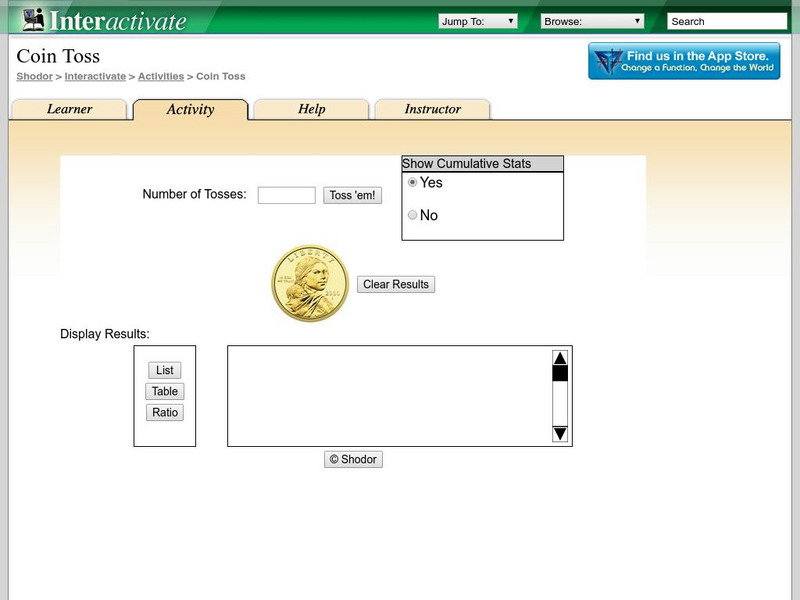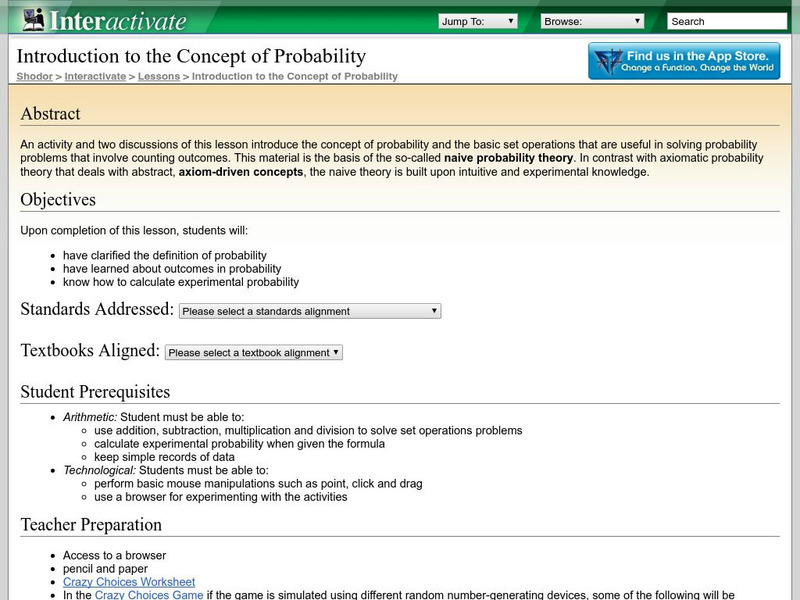Alabama Learning Exchange
Alex: Probability What Are the Odds?
This lesson introduces middle schoolers to experimental and theoretical probability using spinners and trials with pennies. Students also research careers that involve probability, and create a video presentation. It provides an...
McGraw Hill
Glencoe: Self Check Quizzes 2 Theoretical and Experimental Probability
Use Glencoe's Math Course 2 randomly generated self-checking quiz to test your knowledge of Theoretical and Experimental Probability. Each question has a "Hint" link to help. Choose the correct answer for each problem. At the bottom of...
McGraw Hill
Glencoe: Self Check Quizzes the Language of Chance
Questions are randomly created to quiz learners on the language of chance. Hints and solutions are included.
Varsity Tutors
Varsity Tutors: Hotmath: Practice Problems: Probability
Twenty-three problems cover a variety of probability topics. They are given with each step to the solution cleverly revealed one at a time. You can work each step of the problem then click the "View Solution" button to check each step of...
Oswego City School District
Regents Exam Prep Center: Theoretical Versus Empirical Probability
Use this site to learn the difference between theoretical and empirical probability. A practice page is included for each and two teacher resource pages contain classroom activities.
OER Commons
Oer Commons: Experimental Probability
Young scholars will extend their understanding of probability by continuing to conduct experiments, this time with four-colored spinners. They will compare experimental results to expected results by first conducting an experiment, then...
Other
The Actuarial Foundation: Are You Game? [Pdf]
Games are designed to help students understand and apply concepts of probability. determine fairness.
American Chemical Society
American Chemical Soc.: Best of Wonder Science: Give Probability a Chance! [Pdf]
A simple experiment to test the probability of finding an eraser placed under one of two cups.
Shodor Education Foundation
Shodor Interactivate: Lesson: Ideas That Lead to Probability
This lesson plan sets the ground work for an introduction to and then exploring the concepts that are the foundation for probability. Lots of resources are available for teachers and students at this website.
Shodor Education Foundation
Shodor Interactivate: Lesson: Conditional and Simultaneous Probability
This lesson plan deals with conditional probability and the probability of simultaneous events. Problems included in this lesson tend to have solutions that are counterintuitive. This presents an opportunity to investigate more deeply...
Shodor Education Foundation
Shodor Interactivate: Coin Toss
A simple coin-toss simulation through which students explore experimental probability. Accompanied by links to related activities, discussions, worksheets, and materials for instructors.
Shodor Education Foundation
Shodor Interactivate: Lesson: Intro to the Concept of Probability
The Shodor Education Foundation provides this lesson plan to introduce students to the concepts of probability. Students learn about the definition of, outcomes in, and calculations of experimental probability. Students use an...
Shodor Education Foundation
Shodor Interactivate: Marbles
Students learn about sampling with and without replacement by simulating marbles being drawn out of a bag. Settings can be altered to explore conditional probability.
Texas Instruments
Texas Instruments: Plinko!
In this activity, students will simulate a popular game, find experimental probabilities, and then compare those probabilities to the corresponding theoretical probabilities.
Texas Instruments
Texas Instruments: Numb3 Rs: A Bit of Basic Blackjack
Based off of the hit television show NUMB3RS, this lesson explores a little probability in the world of the card game Blackjack. While gambling is not mentioned or used in the lesson, students do find the probability of attaining a...
Texas Instruments
Texas Instruments: Is What Should Happen What Will Happen?
Students will investigate the differences between theoretical and experimental probability.
Texas Instruments
Texas Instruments: Switch or Stick?
In this activity, students will simulate a popular game to find experimental probabilities.
Texas Instruments
Texas Instruments: Heads Up! (Continued)
In this activity, students explore how to write and enter a calculator program that will simulate coin tossing for a given number of times and count the number of heads and tails. They analyze the program and modify it.
Texas Instruments
Texas Instruments: Will Girls and Boys Be Equal?
Students explore concepts in probability and statistics. In this activity, they model a situation to find experimental probability and construct a box-and-whisker plot. They compare the experimental and theoretical probabilities for the...
Texas Instruments
Texas Instruments: Number Cube Sums
Students explore experimental probability and patterns in fractions, decimals, and percents by rolling two number cubes and recording and analyzing the sums that come up.
Texas Instruments
Texas Instruments: You're Probably Right, It's Wrong
In this activity, students perform a simulation to guess answers on a test and determine the experimental probability of passing the test. They then compare it with the theoretical probability.
Texas Instruments
Texas Instruments: Heads Up!
In this activity, students study some important concepts of probability. They use coin tossing experiments to determine the probability of a tossed coin coming up heads. They examine both short and long term experimental probabilities...
Texas Instruments
Texas Instruments: Law of Large Numbers: Equal Opportunities
In this activity, students can use the Probability Simulation application to roll a fair die and explore the Law of Large Numbers. They will conduct probability experiments that involve tossing a fair die, graph the results, compare the...
Texas Instruments
Texas Instruments: The Ordinary Man
In this activity, students estimate the heights of people and compare the estimates to the actual heights in a scatter plot.






















